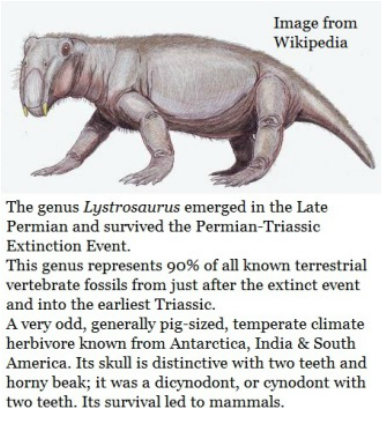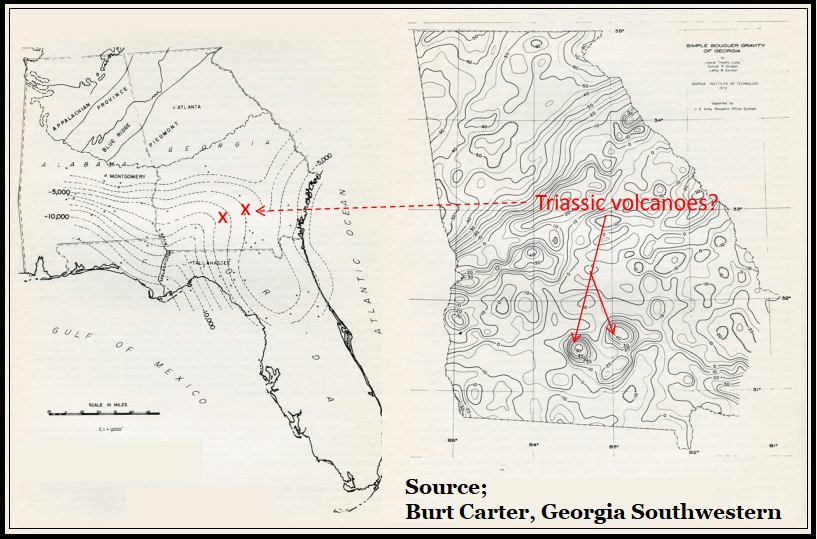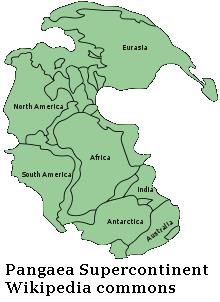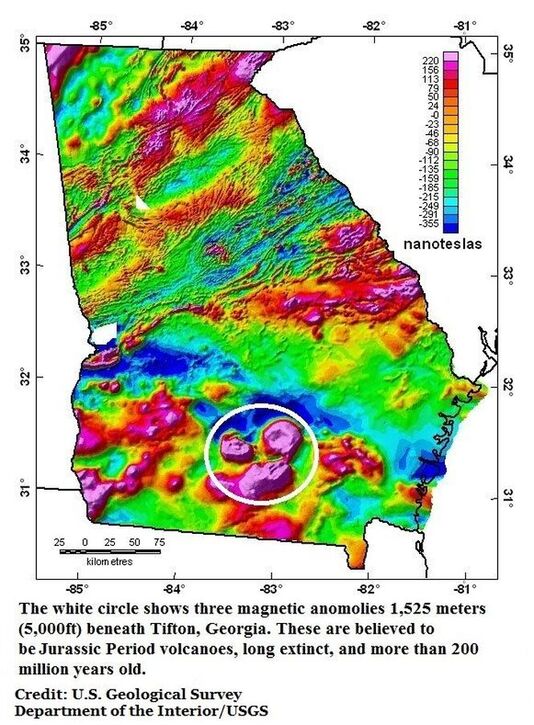5: Georgia Before The Dinosaurs
Georgia's Volcanoes
At this point in Georgia’s history volcanoes appeared in our state and though most have long ago eroded away the evidence of their presence can be seen in the varied mineral deposits of places like Graves Mountain in Lincoln County, Georgia. Graves Mountain is a popular mineral collecting site for Georgia’s rock clubs.
It’s very likely that there are other, more recent, Georgia volcanoes buried deep beneath our Coastal Plain. Dr. Carter spoke at a 2012 meeting of the Mid-Georgia Gem and Mineral Society and mentioned magnetic anomalies on the Coastal Plain in passing during a talk on the Suwannee Current and Gulf Trough.
Tifton, in South Georgia, sits about 65 miles from the nearest coastline and is about 109 meters (360ft) above sea level. The sediments below Tifton reach 1,525 meters (5,000ft) vertically before you encounter bedrock.
That’s nearly 1400 meters (4,600ft) below sea level.
This bedrock dates to the Triassic Period; at least 200 million years old and hosts large magnetic anomalies which probably represent ancient, extinct volcanoes.
Originally described in 1974, anomalies create a magnetic disturbance, such as a large deposit of igneous material might. The theory that these are volcanoes is supported by intrusions of magma, or magmatic dikes, in local sediments.
I asked Scott Harris at Fernbank Science Center in Atlanta about these anomalies. His reply was simple: “It's well-established that there are voluminous flood basalts of the earliest Jurassic beneath the Coastal Plain sediments.”
Flood Basalts are large areas covered with basalt lava. Scott Harris pointed out that Dr. Tim Chowns at the University of West Georgia had researched these anomalies in detail.
Georgia’s geologic history is full of surprises.
At this point in Georgia’s history volcanoes appeared in our state and though most have long ago eroded away the evidence of their presence can be seen in the varied mineral deposits of places like Graves Mountain in Lincoln County, Georgia. Graves Mountain is a popular mineral collecting site for Georgia’s rock clubs.
It’s very likely that there are other, more recent, Georgia volcanoes buried deep beneath our Coastal Plain. Dr. Carter spoke at a 2012 meeting of the Mid-Georgia Gem and Mineral Society and mentioned magnetic anomalies on the Coastal Plain in passing during a talk on the Suwannee Current and Gulf Trough.
Tifton, in South Georgia, sits about 65 miles from the nearest coastline and is about 109 meters (360ft) above sea level. The sediments below Tifton reach 1,525 meters (5,000ft) vertically before you encounter bedrock.
That’s nearly 1400 meters (4,600ft) below sea level.
This bedrock dates to the Triassic Period; at least 200 million years old and hosts large magnetic anomalies which probably represent ancient, extinct volcanoes.
Originally described in 1974, anomalies create a magnetic disturbance, such as a large deposit of igneous material might. The theory that these are volcanoes is supported by intrusions of magma, or magmatic dikes, in local sediments.
I asked Scott Harris at Fernbank Science Center in Atlanta about these anomalies. His reply was simple: “It's well-established that there are voluminous flood basalts of the earliest Jurassic beneath the Coastal Plain sediments.”
Flood Basalts are large areas covered with basalt lava. Scott Harris pointed out that Dr. Tim Chowns at the University of West Georgia had researched these anomalies in detail.
Georgia’s geologic history is full of surprises.

The Global Perspective
During the Devonian Period (416 to 359 million years ago) the vertebrates took to land; four limbed terrestrial vertebrates, the tetrapods, emerge into the fossil record. Tetrapods include birds, reptiles, amphibians and our own mammal class.
The earliest tetrapods were the amphibians.
Amphibians overcame the problems of walking on land and breathing atmosphere; they were (and are) still tied to the water, their soft shelled eggs require water or at least heavy moisture and their skin must also be kept moist.
Some members of the amphibian class became large predators; specifically the order Temnospondyli saw amphibians reaching up to 9 meters (29.5 feet) in length; this was the alligator-like Prionosuchus which lived in Brazil about 270 million years ago. I say alligator-like as Prionosuchus is more closely related to modern salamanders than alligators.
Reptiles emerged from the amphibians. Their eggs were (and are) sealed, making them capable of surviving without water. Their thicker scaled skin seals their bodies and allows them to retain moister.
The reptiles gave rise to the dinosaurs which were a wonderful evolutionary success enduring for more than 150 million years and diversifying wildly.
Reptiles also gave rise to the synapsids at about 300 million years ago, which, in time, produced mammals and eventually; human line of primates.
At about 260 million years ago the cynodonts emerged, our family tree though there are many more branches to go before monotremes, marsupials, placental mammals, primates and eventually mammals come along.
During the Devonian Period (416 to 359 million years ago) the vertebrates took to land; four limbed terrestrial vertebrates, the tetrapods, emerge into the fossil record. Tetrapods include birds, reptiles, amphibians and our own mammal class.
The earliest tetrapods were the amphibians.
Amphibians overcame the problems of walking on land and breathing atmosphere; they were (and are) still tied to the water, their soft shelled eggs require water or at least heavy moisture and their skin must also be kept moist.
Some members of the amphibian class became large predators; specifically the order Temnospondyli saw amphibians reaching up to 9 meters (29.5 feet) in length; this was the alligator-like Prionosuchus which lived in Brazil about 270 million years ago. I say alligator-like as Prionosuchus is more closely related to modern salamanders than alligators.
Reptiles emerged from the amphibians. Their eggs were (and are) sealed, making them capable of surviving without water. Their thicker scaled skin seals their bodies and allows them to retain moister.
The reptiles gave rise to the dinosaurs which were a wonderful evolutionary success enduring for more than 150 million years and diversifying wildly.
Reptiles also gave rise to the synapsids at about 300 million years ago, which, in time, produced mammals and eventually; human line of primates.
At about 260 million years ago the cynodonts emerged, our family tree though there are many more branches to go before monotremes, marsupials, placental mammals, primates and eventually mammals come along.

The Permian-Triassic Extinction Event
Extinction events are large scale die-offs of multiple species; they can be local, regional or global. Here we’re discussing a terrible, global event. There are five, major, global extinction events recorded in the Earth’s fossil record. There are many lesser extinction events. The Permian-Triassic Extinction Event is by far the most serious and came close to erasing advanced animal life on Earth.
About 251 million years ago 96% of all marine species and 70% of all terrestrial species globally disappeared from the fossil record forever.
Furthermore; this is the only known extinction event in Earth’s history which dramatically impacted the insects. Even plants, which are usually resistant to extinction events, were impacted. There are no reliable numbers about the loss of plant species and a great deal isn’t known about how many species existed before and after, but it is evident that there was a mass rearrangement of plant distributions and abundances.
What triggered the Permian-Triassic Extinction Event is also unknown and very little is known about what actually happened, however the event occurred in a series of phases which still defy explanation.
Recovery to the previous levels of biodiversity took upwards of ten millions years.
Note; On Saturday 09/Sept/2023 I ppost this page on Facebook, Georgia's Fossils Group and had this question...
I live in Nashville GA. I'm curious, what sort of equipment goes 5k feet below the surface? I assume these magnetic anomalies cannot be detected from current surface areas? Is it only by accessing the 5k feet below that this was discovered? This is so neat! Because it looks like from the map also, the volcanoes were right here where I live. Jessica Miller Wheeler
I deferred her question to Burt Carter, who replied on that same day...
The anomalies are detected from the surface. Or, actually, above it. "Anomaly" just means "unexpected result" or in this case, "unexpected value".
The magnetic field at any place can be measured very precisely with an instrument called a magnetometer.
Almost all of the Coastal Plain is underlain by sediments only, with very few magnetic minerals in them. Therefore the expected value for total magnetic field should be roughly equal to the strength of the Earth's ordinary magnetic field. The magnetic field where the two round volcanoes are buried in south Georgia has much higher than expected values, and the concentrically increasing values towards their centers suggest volcanoes similar in shape and composition to Mts Kenya and Kilimanjaro in the East African Rift Zone.
There are volcanic rocks (basalt) from wells in the Coastal Plain and outcrops in the Piedmont that date the volcanism to the Triassic, when we were rifting from Pangaea. Basaltic volcanism would be expected in that setting , just as it is in the East African Rift and the ocean ridge rifts.
There are also magnetic anomalies caused by many dikes along the edges of the rift valleys in the southern Atlantic Coastal Plain, with the south Georgia volcanoes within the valley. In North Carolina and Northward numerous rift valleys are actually exposed in the Piedmont and Triassic. Land fossils (like Tim Chowns' lizard) are frequently found. The first dinosaur fossils found in the US were from the Connecticut Valley, in Triassic rift sediments.
Basalt is much denser than sediments and so the volcanoes all show up as gravity anomalies as well as magnetic anomalies.
Magnetometers can be set up on the ground, but they also work in airplanes or satellites flying over an area, or being towed behind ships at sea, which is how the famous "zebra-stripe map" that led to the discovery of seafloor spreading was made. Dr. Burt Carter
References;
Personal communication with Dr. Burt Carter, Georgia Southwestern State University.
Personal Communication with R. Scott Harris, Fernbank Science Center.
Extinction events are large scale die-offs of multiple species; they can be local, regional or global. Here we’re discussing a terrible, global event. There are five, major, global extinction events recorded in the Earth’s fossil record. There are many lesser extinction events. The Permian-Triassic Extinction Event is by far the most serious and came close to erasing advanced animal life on Earth.
About 251 million years ago 96% of all marine species and 70% of all terrestrial species globally disappeared from the fossil record forever.
Furthermore; this is the only known extinction event in Earth’s history which dramatically impacted the insects. Even plants, which are usually resistant to extinction events, were impacted. There are no reliable numbers about the loss of plant species and a great deal isn’t known about how many species existed before and after, but it is evident that there was a mass rearrangement of plant distributions and abundances.
What triggered the Permian-Triassic Extinction Event is also unknown and very little is known about what actually happened, however the event occurred in a series of phases which still defy explanation.
Recovery to the previous levels of biodiversity took upwards of ten millions years.
Note; On Saturday 09/Sept/2023 I ppost this page on Facebook, Georgia's Fossils Group and had this question...
I live in Nashville GA. I'm curious, what sort of equipment goes 5k feet below the surface? I assume these magnetic anomalies cannot be detected from current surface areas? Is it only by accessing the 5k feet below that this was discovered? This is so neat! Because it looks like from the map also, the volcanoes were right here where I live. Jessica Miller Wheeler
I deferred her question to Burt Carter, who replied on that same day...
The anomalies are detected from the surface. Or, actually, above it. "Anomaly" just means "unexpected result" or in this case, "unexpected value".
The magnetic field at any place can be measured very precisely with an instrument called a magnetometer.
Almost all of the Coastal Plain is underlain by sediments only, with very few magnetic minerals in them. Therefore the expected value for total magnetic field should be roughly equal to the strength of the Earth's ordinary magnetic field. The magnetic field where the two round volcanoes are buried in south Georgia has much higher than expected values, and the concentrically increasing values towards their centers suggest volcanoes similar in shape and composition to Mts Kenya and Kilimanjaro in the East African Rift Zone.
There are volcanic rocks (basalt) from wells in the Coastal Plain and outcrops in the Piedmont that date the volcanism to the Triassic, when we were rifting from Pangaea. Basaltic volcanism would be expected in that setting , just as it is in the East African Rift and the ocean ridge rifts.
There are also magnetic anomalies caused by many dikes along the edges of the rift valleys in the southern Atlantic Coastal Plain, with the south Georgia volcanoes within the valley. In North Carolina and Northward numerous rift valleys are actually exposed in the Piedmont and Triassic. Land fossils (like Tim Chowns' lizard) are frequently found. The first dinosaur fossils found in the US were from the Connecticut Valley, in Triassic rift sediments.
Basalt is much denser than sediments and so the volcanoes all show up as gravity anomalies as well as magnetic anomalies.
Magnetometers can be set up on the ground, but they also work in airplanes or satellites flying over an area, or being towed behind ships at sea, which is how the famous "zebra-stripe map" that led to the discovery of seafloor spreading was made. Dr. Burt Carter
References;
Personal communication with Dr. Burt Carter, Georgia Southwestern State University.
Personal Communication with R. Scott Harris, Fernbank Science Center.


